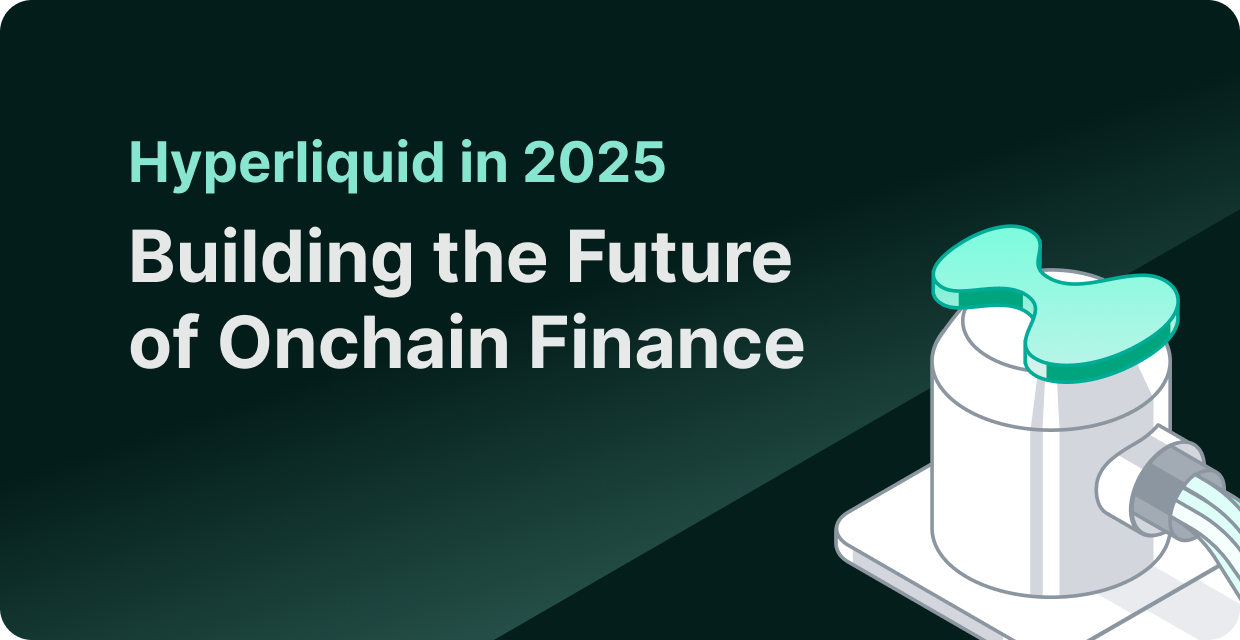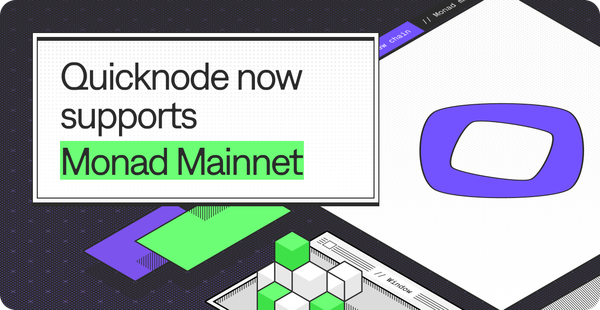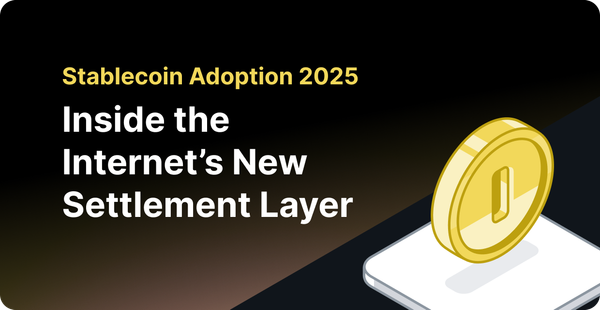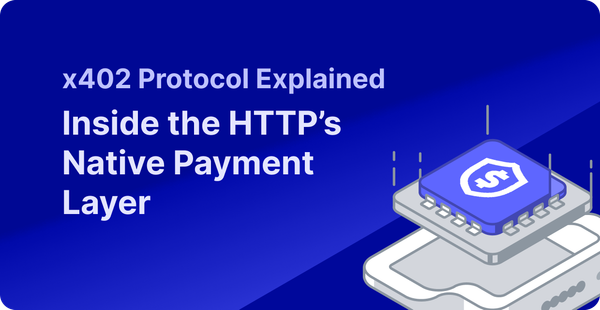Hyperliquid in 2025: A High-Performance DEX Building the Future of Onchain Finance
Explore how hyperliquid became the leading perp DEX: A deep dive of architecture, metrics, tokenomics, and vision for onchain finance.

Key takeaways
- DEX market is maturing with DEXs capturing 20% of crypto trading volume and perpetual futures accounting for 65% of DEX activity.
- With a 76.7% market share and over $1.5 trillion in total volume, Hyperliquid is the undisputed leader in onchain perpetual futures.
- HyperBFT (consensus), HyperCore (execution), and HyperEVM (smart contracts) operate in a unified state — enabling performance, liquidity, and composability on a single chain.
- 97% of protocol revenue goes into buying back $HYPE. With no VC allocations, the model prioritizes community ownership and long-term deflation.
- HyperUnit allows native BTC, ETH, and SOL deposits without custodial wrappers or synthetic assets, enabling true collateral mobility and regulatory-aware design.
What if a decentralized exchange could match the performance of a centralized one and then go even further?
Hyperliquid is doing just that. In a world where DeFi platforms are racing to scale, Hyperliquid has quietly built a vertically integrated protocol that combines trading, tokenization, and smart contract execution.
This report explores how it works, how far it’s come, and whether it could become the foundational layer for all of onchain finance.
Macro Lens: Explore The DEX Landscape in 2025
The decentralized exchange (DEX) ecosystem in 2025 stands at a pivotal juncture. What began as an alternative to centralized custodianship has matured into a core pillar of onchain financial infrastructure.
While centralized exchanges still dominate raw volume, DEXs are steadily closing the gap. In 2025, DEXs are generating $15-20 billion in daily trading volume, commanding nearly 20% of total crypto trading volume which is a remarkable evolution from their nascent beginnings.
This is being driven by improvements in execution, capital efficiency, and user experience.
Outside trading volume, there are more numbers suggesting a positive outlook for DEXs:
- DEX derivatives volumes alone grew 132% in 2024 to reach $1.5 trillion and further forecast that the market can reach $3.48T in 2025
- Perpetual DEXs now account for approximately 24.34% of total perpetual futures volume, up from just 4.5% in January 2024 — a 5x market share expansion.
- Perpetual DEXs now account for 65% of total DEX volume in 2025.
As DEX infrastructure matures, one product category stands out as both a driver and beneficiary of this shift: perpetual futures.
To fully understand the rise of platforms like Hyperliquid, it’s essential to first understand why perpetuals are central to the evolution of onchain trading.
Understanding Perpetual Futures in Crypto
Perpetual futures, or “perps,” are synthetic derivative contracts that allow traders to speculate on the price of an asset without owning it and without an expiry date.
First popularized by BitMEX, perps have become the dominant trading instrument in crypto, now accounting for over 65% of total DEX volume.
The mechanism that makes perpetuals unique is the funding rate system.
The funding rate is applied to the notional value of a trader's open position every eight hours, with payments flowing between long and short position holders to keep the perpetual contract price aligned with the underlying spot market.
- When perpetual prices trade above spot prices, long position holders pay short holders
- When prices trade below, the payment flows reverse, meaning short holders pay long position holders.
This elegant solution addresses the core challenge of derivatives pricing without expiration dates.
For DEXs, perpetuals are not just a high-volume product, they are a proving ground for performance, UX, and capital efficiency. Delivering perps onchain requires minimizing latency, supporting high throughput, and designing robust liquidity and risk management systems.
Platforms like Hyperliquid are gaining traction precisely because they’ve managed to meet these demands while keeping the experience competitive with CEXs.
Inside Hyperliquid: Unpacking the Top Performing Perp DEX of 2025
In a market increasingly defined by performance, Hyperliquid has emerged as the clear frontrunner among perpetual DEXs in 2025 with nearly 500k unique users.
Over the last 30 days alone, it has generated $65.45 million in protocol revenue which is more than the next five perp DEXs combined. Its dominance is not marginal; Hyperliquid consistently captures 70–75% of total perp DEX trading volume, making it nearly 8x larger than its closest competitor.
What sets Hyperliquid apart isn't just its current market position, but its architectural approach to building onchain financial infrastructure.
Let’s take a quick look at how Hyperliquid has reimagined the operations of a trading platform when built from the ground up for blockchain-native finance.
Hyperliquid High Level Architecture
Hyperliquid isn’t just a trading platform, it is a vertically integrated blockchain stack purpose-built for low-latency, high-performance financial applications. The architecture is composed of three tightly coupled layers: HyperBFT, HyperCore, and HyperEVM, all operating in a single unified state.
These components enable low-latency execution, deep liquidity, and EVM-level programmability — all on the same chain.
- HyperBFT is Hyperliquid’s custom Byzantine Fault Tolerant consensus mechanism
HyperBFT provides fast finality and ensures that all nodes agree on the state of applications — whether they run on HyperCore or HyperEVM. This consensus layer is optimized for throughput and consistency, laying the foundation for high-performance financial execution.
- HyperCore is the execution engine built for financial speed
HyperCore powers Hyperliquid’s native applications like perpetual and spot order books, lending markets, oracles, vaults, and auction mechanisms. These are not smart contracts — they are tightly integrated modules that deliver unmatched latency and capital efficiency.
By controlling this layer directly, Hyperliquid ensures performance that rivals even centralized exchanges.
- HyperEVM is Hyperliquid’s general-purpose smart contract environment
HyperEVM, introduced in February 2025, brings Ethereum Virtual Machine compatibility to the ecosystem, allowing developers to build traditional EVM-based dapps.
Unlike other rollups or modular chains, HyperEVM is not siloed. It coexists with HyperCore in the same global state, enabling composable interactions between user-built applications and native financial infrastructure.
The architectural advantage of Hyperliquid lies in its unified state model.
Applications built on HyperEVM can directly interact with HyperCore primitives — enabling seamless flows between programmability and performance.
For example: A strategy vault deployed via HyperEVM can route trades through the HyperCore perp engine without needing bridges, external calls, or state syncs..
The breakthrough is seamless interoperability between layers:
- Direct Price Feeds: Lending smart contracts can read prices directly from HyperCore order books using a read precompile - as simple as calling a built-in function for Solidity developers.
- Native Liquidations: Smart contracts can send orders directly to HyperCore order books using write system contracts enabling protocolized liquidations.
- No Bridging Risk: No bridging risk between HyperCore and HyperEVM as one unified state which is a 10x product improvement over CEXs.
To understand why Hyperliquid’s architecture is so differentiated, it helps to trace how the project came to be and why it was built this way in the first place.
What is the History of Hyperliquid?
Launched in stealth and developed by a pseudonymous team, Hyperliquid emerged in 2022 with a singular focus: build an onchain trading platform that matches or exceeds centralized exchange performance. Its growth has been rapid, methodical, and rooted in first-principles engineering.
2022–2023: Origins as a Perpetual DEX
Launched in 2022, Hyperliquid began as a perpetual futures DEX with one goal — combine the speed and UX of centralized exchanges with DeFi transparency and custody. Instead of using AMMs, it introduced an on-chain order book offering deep liquidity, low slippage, and near-zero gas fees.
Backed by a custom Tendermint-based chain, it supported over 20 assets, up to 50x leverage, and boasted 20,000 orders per second.
By 2023, Hyperliquid had quietly gained traction, launching a closed alpha mainnet with advanced order types and real-time execution.
2023–2024: Building Hyperliquid L1
To scale performance further, Hyperliquid transitioned into a fully sovereign Layer 1 chain: Hyperliquid L1 which is powered by its custom consensus engine, HyperBFT, offering sub-second finality and 100K+ orders/sec throughput.
This phase introduced:
- Zero gas trading
- Community-owned liquidity pools
- HyperEVM
By late 2024, it had captured over 70% of perp DEX market share, with daily trading volumes hitting $13.9B and cumulative volume surpassing $428B.
2024–2025: Ecosystem Expansion and Token Launch
In November 2024, Hyperliquid launched the $HYPE token with a transparent distribution:
- 31% to early users,
- 38.8% for future incentives,
- No VC allocations.
HYPE quickly gained traction, unlocking governance, staking (2% APR), and fee discounts.
Meanwhile, ecosystem growth accelerated:
- HIP-1/HIP-2 token standards enabled onchain order books for memecoins and tokens.
- dApps launched on HyperEVM included: HyperLend, HypurrFun, PvP.trade, and Hyperdrive.
As of 2025, Hyperliquid is dominating the perp DEX landscape, capturing 70–75% of total perp DEX trading volume.
Hyperliquid’s architectural innovations and strategic evolution tell one part of the story. But to fully understand its standing in the market, we need to quantify that story — through protocol usage, trading behavior, and onchain traction.
Hyperliquid in Numbers: Market, Traction, and Adoption
Hyperliquid's market performance reflects the successful execution of its technical vision, with metrics that demonstrate both scale and operational excellence. These numbers tell the story of a protocol that has not only captured market share but created an entirely new standard for DEX performance.
Market Dominance
- Top 10 Market share in Perp DEXs: 76.7% (8x larger than #2)
- Total Volume: $1,519,906,269,933 ($1.52 trillion)
- Total Open Interest: $9 Billion
- Current daily revenue: $2.04M
- Annualized revenue: $871.1M (based on 30-day moving average)
Sources: Perp Volume - DefiLlama | Hyperliquid Stats
User & Platform Metrics
- Total Users: 466,070
- Uptime: 99.99%
- Trading capacity: 100,000 orders/second
- Latency: 0.2 seconds
- Assistance Fund: $901,044,871
Sources: Hyperliquid Stats | Overview | Hyperliquid Docs | HYPE Burn
Market Health Indicators
- Annualized Funding Rate: ETH: 11.41% BTC: 10.95% SOL: 7.95%
Sources: Hyperliquid Stats
Along with volume and adoption, Hyperliquid's momentum has sustained and grown thanks to a carefully designed economic model that aligns platform growth with user incentives through the HYPE token and its distribution strategy.
Hyperliquid: Tokenomics and Incentive Strategy
Hyperliquid's approach to tokenomics shows how the team and the project prioritized community ownership through one of the most generous token distributions in DeFi history.
Token Distribution Architecture
On 29 November 2024, the HYPE token launched with one of the largest retail distributions in crypto history, airdropping 310 million tokens to nearly 100,000 users.
The airdrop was the culmination of a six-month points-based rewards system, emphasizing consistent, high-frequency participation on the platform. The remaining distribution follows a community-first philosophy:
- 38.8% reserved for future community rewards,
- 23.8% for core contributors (locked for one year), and
- 6% for the Hyper Foundation.
Unlike conventional models, the distribution had no vesting schedules, no VC allocations, and no preferential insider rounds.
On day 1, the value distributed exceeded $2 billion, with average user allocations ranging from $45,000 to $50,000.
This ensures that the early users and active community members capture the majority of token value rather than pre-seed investors.
Market Response
The market response validated the distribution strategy immediately.
HYPE surged from $3.20 to $4.80 within hours of the airdrop, generating over $165 million in trading volume in the first hour alone.
By June 2025, the token reached $37.45, representing a 460.68% gain from the airdrop price and creating over $7 billion in distributed value.
Utility and Economic Design
$HYPE is not just a governance token. It plays a structural role in aligning protocol-level behavior:
- Governance: Token holders participate in key decisions around protocol upgrades, fees, and incentive allocations.
- Staking: A base staking APR (2%) is offered, funded from protocol revenue, with future plans for staking-as-insurance models.
- Fee Discounts: Active traders and ecosystem participants receive trading fee rebates and tiered incentives via HYPE staking.
- Ecosystem Growth: 38.8% of supply is reserved for future rewards, enabling long-term incentive alignment for users, builders, and liquidity providers.
This functional design ensures that HYPE remains embedded in the economic loop of the Hyperliquid ecosystem.
The massive scale of the airdrop catalyzed ecosystem growth almost immediately:
- Projects like HypurrFun, HyperLend, and PvP.trade launched post-airdrop
- Hyperliquid’s native standards — HIP-1 and HIP-2 — allowed new tokens to inherit liquidity and trade natively
- DEX liquidity surpassed $2B, demonstrating stickiness and composability
The airdrop created an immediate user base and funding flywheel, compressing the typical builder-incentive-user loop into a short timeframe.
Deflationary Revenue Model
Hyperliquid's tokenomics are underpinned by a sophisticated deflationary mechanism that redirects platform revenue toward consistent buybacks and burns of HYPE tokens.
The Assistance Fund uses 97% of protocol revenue to buy back HYPE tokens, creating direct correlation between platform growth and token scarcity.
Currently, the Assistance Fund holds 23,975,621.92 HYPE worth over $900 Million (at the time of writing), with all buyback activity transparently tracked in real-time.
In parallel, Hyperliquid also implements direct fee-based token burns, with 267,161 $HYPE already removed from circulation.
The current burn rate stands at:
- 2,000 HYPE per day
- Annualized: 721.8K HYPE
- Annualized Burn Rate: 0.07%
This dual mechanism combining reserve-based buybacks and direct burns ensures constant downward pressure on supply as usage scales.
Auction-Based Ticker Listings
Hyperliquid also generates additional revenue through Dutch auctions for ticker listings on its order book.
New assets must win a spot via auction, typically priced around $40K, but with some bids reaching over $1M. These auctions run 1–2 times per day, lasting ~31 hours each, and feed revenue back into the Accounting Fund, which is also used for HYPE buybacks.
This design serves multiple purposes:
- Adds deflationary pressure through non-dilutive monetization
- Introduces a decentralized, permissionless asset listing process
- Filters low-quality tokens through economic commitment
Why This Matters: A Self-Sustaining Flywheel
This model creates three structural priorities that differentiate Hyperliquid from VC-backed protocols:
- Self-sustaining revenue model: No dependence on external funding or team token sales
- Controlled circulation: Buyback pressure offsets future emissions while maintaining token utility
- Community-first economics: All economic value flows back to token holders rather than insiders.
While Hyperliquid's financial performance and tokenomics demonstrate clear product-market fit in perpetual trading, the platform's ultimate ambition extends far beyond capturing DEX market share, it aims to become the foundational infrastructure for all onchain finance.
Hyperliquid and the House of Finance Vision
Hyperliquid may lead the perpetual DEX market today, but its true ambition runs deeper: to become the financial operating layer of web3.
With a unified architecture spanning HyperCore, HyperEVM, and HyperUnit, Hyperliquid is laying the foundation for an onchain ecosystem where trading, tokenization, and settlement converge seamlessly across all major assets and use cases.
Unit: Hyperliquid’s Native Tokenization Protocol
Unit or HyperUnit is Hyperliquid’s native tokenization protocol and it reimagines how assets move between blockchains and interact within DeFi ecosystems.
Launched in February 2025, Unit enables users to deposit and withdraw native assets like BTC, ETH, and SOL without relying on centralized bridges or custodial wrappers. Instead, it uses a distributed Guardian network that verifies and executes asset flows through a threshold signature scheme, ensuring full user custody at all times.
Since launch, Unit has already facilitated over $5.3 billion in spot trading volume with $3.8 billion in BTC alone.
More than a UX convenience, Unit is a strategic cornerstone. It unlocks:
- Unified trading of spot and derivatives in a single venue
- Collateral mobility, allowing BTC and ETH to be used directly in margin accounts
- Cross-asset portfolio margining and efficient liquidation rails
- Composable, onchain treasury management for DAOs and protocols
Crucially, Unit also serves as a compliance-aware infrastructure layer. It includes built-in mechanisms for OFAC filtering, IP-based access control, and other regulatory safeguards — striking a pragmatic balance between decentralization and institutional readiness.
As of now, Unit operates via a 3-Guardian quorum (Hyperliquid, Unit, Infinite Field), but expansion and governance decentralization remain on the roadmap.
Bringing it all Together: Unit, HyperEVM, and HyperCore
HyperUnit is only one piece of the puzzle.
What gives Hyperliquid its unique edge is how seamlessly this tokenization layer connects with the rest of its stack.
- HyperCore, the low-latency execution engine behind perps, spot, and other high-frequency primitives, and
- HyperEVM, the Ethereum-compatible smart contract layer, both operate within a shared global state.
That means assets entering through Unit don’t just sit idle, they instantly become usable across all parts of the system: as margin, in smart contracts, or in composable dApps.
This architectural unity turns Hyperliquid into a powerful vertically integrated platform where performance, liquidity, and programmability converge by design.
The Unified Financial Operating System: What This Enables
When tokenization (Unit), programmability (HyperEVM), and execution (HyperCore) operate within a single, composable system, the design space for onchain finance radically expands. They unlock financial primitives that have never been possible in DeFi at this scale.
- Use native assets as margin: Deposit native assets and instantly use them as collateral for perp positions without wrapping or bridging.
- Instant liquidation rails: DeFi protocols can liquidate positions by routing directly through HyperCore order books with sub-second execution speeds.
- Treasury management: DAOs manage multi-asset portfolios with sophisticated rebalancing and hedging strategies through integrated HyperEVM applications.
- Onchain structured products: Build options, basis trades, and cross-chain yield products directly on Hyperliquid using real assets and execution rails.
- Native options settlement: Options contracts settle instantly using spot assets, enabling real-time delta hedging with zero settlement risk.
This convergence transforms Hyperliquid from a specialized trading venue into a comprehensive financial operating system where any asset can be traded, borrowed, hedged, and composed with institutional performance standards.
Building on HyperEVM: Discover Hyperliquid Ecosystem Projects
With the core architecture in place, Hyperliquid is no longer just hosting financial primitives, it’s becoming fertile ground for developers to build next-generation applications directly onchain. The following applications demonstrate the practical potential of building on unified financial infrastructure.
SocialFI & Trading Tools
- HypurrFun operates as the fastest Telegram trading bot for Hyperliquid, with profits flowing to $HFUN token buybacks.
- HypurrPump brings the "pump.fun" model to Hyperliquid's infrastructure, similarly directing revenue to $HFUN appreciation.
- fanfun pioneers subscription-based creator economics, allowing fans to subscribe for exclusive access while speculating on creator growth trajectories.
- pvp.trade enhances group trading dynamics through its Telegram bot integration, enabling seamless trade sharing and execution within trading communities.
Cross-Chain Infrastructure
Multiple bridge solutions have integrated with Hyperliquid, each optimizing for different use cases.
- Across Protocol leverages intents for fast, low-cost transfers without traditional bridge security tradeoffs.
- Gasyard connects multiple VMs including Solana, Aptos, and Bitcoin in under 10 seconds.
- HyBridge specializes in multi-token transfers from 6 EVM chains plus Solana and Bitcoin directly to USDC on Hyperliquid.
- Nitro by Router provides single-step bridging from over 35 chains, while
- deBridge focuses on lightspeed execution across its supported networks.
DeFi Protocols
- Solv Protocol brings Bitcoin staking capabilities via SolvBTC, unlocking yield potential for over $1 trillion in Bitcoin assets.
- Felix operates as Hyperliquid's native CDP protocol, offering coin margin through feUSD, a censorship-resistant stablecoin with sustainable native yield.
- HyperLend focuses on efficient cryptocurrency lending and borrowing.
- HypurrFi stabilizes volatile yield into the UST-backed USDXL stablecoin.
- Spectra specializes in interest rate derivatives with EVM-native infrastructure, completing the spectrum of sophisticated financial instruments available within the ecosystem.
Will Hyperliquid House All of Onchain Finance?
Hyperliquid’s rise from a high-performance perpetual DEX to a full-stack financial platform is one of the most compelling evolutions in DeFi.
With a vertically integrated architecture — spanning native tokenization, real-time execution, and programmable liquidity — the protocol is pushing the boundaries of what onchain finance can look like.
That said, whether Hyperliquid becomes the home for all of onchain finance remains an open question.
Much depends on how the ecosystem navigates upcoming challenges: decentralizing core infrastructure, balancing regulatory constraints, attracting diverse builders, and expanding cross-chain interoperability.
What’s clear, however, is that Hyperliquid has been architected for scale from the start — not just in throughput, but in ambition. This scale and ambition require robust infrastructure support to realize its full potential, which brings us to the critical role of development infrastructure in the Hyperliquid ecosystem.
Powering Hyperliquid Builders with QuickNode
QuickNode is the fastest, most reliable infrastructure provider for Hyperliquid developers giving you everything needed to ship production-ready dApps, bots, protocols, and data pipelines at scale.
Here are some numbers that reflect’s QuickNode’s performance
- 400B+ monthly API requests served globally
- 2.5x faster average response times than competitors
- 99.99% uptime SLA
- 24/7 dev support via Discord and docs
QuickNode covers the entire Hyperliquid stack:
- Reliable & scalable RPC endpoints – connect with a single line of code
- Live event streaming – filtered or raw data with built-in reorg handling
- Historical backfills – access full Hyperliquid history with guaranteed delivery
The integration of QuickNode's infrastructure with Hyperliquid's unified architecture enables developers to focus on building innovative financial solutions and use cases.
Disclaimer
This report is for informational purposes only. It does not constitute investment advice, financial advice, or any recommendation to buy, sell, or participate in any protocol or token. All data and analysis presented here are based on publicly available information and should not be interpreted as endorsement or prediction.
Frequently Asked Questions (FAQs)
- What is the HYPE token used for?
HYPE powers governance, staking, trading incentives, and is subject to ongoing buybacks and burns from protocol revenue and auction sales.
- How does Hyperliquid generate revenue?
Revenue comes from trading fees and Dutch auctions for token listings. 97% of it is redirected to buy back HYPE tokens via the Assistance Fund.
- How is Hyperliquid’s architecture different from rollups or modular chains?
Unlike siloed L2s or appchains, Hyperliquid runs a unified global state where HyperCore and HyperEVM interact natively, offering composability with performance.
- What are the main risks of using Hyperliquid?
Key risks include smart contract vulnerabilities, regulatory uncertainty as the platform expands, the current limited Guardian set for HyperUnit, and general cryptocurrency market volatility.
- What is the future vision for Hyperliquid?
Hyperliquid aims to become the foundational operating layer for onchain finance, unifying trading, tokenization, and programmability
About QuickNode
QuickNode provides the tools and resources builders need to create incredible products. With a globally balanced infrastructure, guaranteed reliability, a user-friendly interface, and end-to-end customer support, QuickNode allows enterprises to realize their ideas on the chain rapidly.






